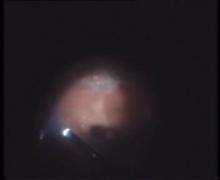Chorioretinitis
Chorioretinitis is an inflammation of the choroid (thin pigmented vascular coat of the eye) and retina of the eye. It is a form of posterior uveitis. If only the choroid is inflamed, not the retina, the condition is termed choroiditis.[1] The ophthalmologist's goal in treating these potentially blinding conditions is to eliminate the inflammation and minimize the potential risk of therapy to the patient.
Symptoms
Symptoms may include the presence of floating black spots, blurred vision, pain or redness in the eye, sensitivity to light, or excessive tearing.[2]
Causes

Chorioretinitis is often caused by toxoplasmosis and cytomegalovirus infections (mostly seen in immunodeficient subjects such as people with HIV or on immunosuppressant drugs).[3] Congenital toxoplasmosis via transplacental transmission can also lead to sequelae such as chorioretinitis along with hydrocephalus and cerebral calcifications. Other possible causes of chorioretinitis are syphilis, sarcoidosis, tuberculosis, Behcet's disease, onchocerciasis, or West Nile virus.[4] Chorioretinitis may also occur in presumed ocular histoplasmosis syndrome (POHS); despite its name, the relationship of POHS to Histoplasma is controversial.[5][6]
Treatment
Chorioretinitis is usually treated with a combination of corticosteroids and antibiotics. However, if there is an underlying cause such as HIV, specific therapy can be started as well.
A 2012 Cochrane Review found weak evidence suggesting that ivermectin could result in reduced chorioretinal lesions in patients with onchocercal eye disease.[7] More research is needed to support this finding.
See also
References
[8]; -webkit-column-width: refs [9] [8]; column-width: refs [9] [8]; list-style-type: decimal;">
- ↑ "Choroiditis (definition)". WebMD. Retrieved July 11, 2012.
- ↑ Berman, Eric L. "Choroiretinitis.". NYU Langone Medical Center. Retrieved July 11, 2012.
- ↑ Kasper; et al., eds. (2005). Harrison's Principles of Internal Medicine (16th ed.). New York: McGraw-Hill. pp. 959, 1038. ISBN 0-07-140235-7.
- ↑ Shaikh S, Trese MT (2004). "West Nile virus chorioretinitis". Br J Ophthalmol. 88 (12): 1599–60. doi:10.1136/bjo.2004.049460. PMC 1772450
 . PMID 15548822.
. PMID 15548822. - ↑ Thuruthumaly, C; Yee, D. C.; Rao, P. K. (2014). "Presumed ocular histoplasmosis". Current Opinion in Ophthalmology 25 (6): 508–12. doi:10.1097/ICU.0000000000000100. PMID 25237930
- ↑ Nielsen, J. S.; Fick, T. A.; Saggau, D. D.; Barnes, C. H. (2012). "Intravitreal anti-vascular endothelial growth factor therapy for choroidal neovascularization secondary to ocular histoplasmosis syndrome". Retina 32 (3): 468–72. doi:10.1097/IAE.0b013e318229b220. PMID 21817958
- ↑ Ejere HOD, Schwartz E, Wormald R, Evans JR (2012). "Ivermectin for onchocercal eye disease (river blindness)". Cochrane Database Syst Rev. 8: CD002219. doi:10.1002/14651858.CD002219.pub2. PMID 22895928.
- 1 2 3 Emmett T. Cunningham; Paul Riordan-Eva. Vaughan & Asbury's general ophthalmology. (18th ed.). McGraw-Hill Medical. ISBN 978-0071634205.
- 1 2 Neil J. Friedman; Peter K. Kaiser; Roberto Pineda (2009). The Massachusetts Eye and Ear Infirmary illustrated manual of ophthalmology (3rd ed.). Saunders/Elsevier. ISBN 978-1437709087.